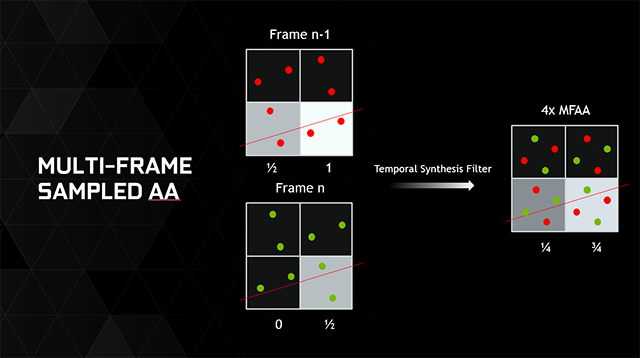Multi-Frame Sampled Anti-Aliasing
Note that this is an archived copy of the original article. Please see here for a more detailed explanation.
By Andrew Burnes on Thu, Sep 18 2014
With the launch of Maxwell we are introducing the world to Multi-Frame Sampled Anti-Aliasing (MFAA). This new, Maxwell-exclusive anti-aliasing technique improves upon the quality of MSAA, whilst simultaneously reducing the performance impact, enabling gamers to crank up rendering resolutions and game detail, and to activate DSR.
Previous-generation GPUs include fixed sample patterns for anti-aliasing (AA) that are stored in Read Only Memory (ROM). When gamers selected 2x or 4x MSAA for example, the pre-stored sample patterns were used. With Maxwell, we have introduced programmable sample positions for rasterization that are stored on Random Access Memory (RAM), creating opportunities for new, more flexible, more inventive AA techniques that uniquely address the challenges of modern game engines, such as the increased performance cost of high-quality anti-aliasing.
Maxwell's new RAM-based sample position technology can still be programmed with standard MSAA and TXAA patterns, but now the driver or application may also load the RAM with custom positions that are free to vary from frame to frame, or even within a frame. And it is with this technology that we have developed Multi-Frame Sampled Anti-Aliasing (MFAA).
By alternating AA sample patterns both temporally and spatially, 4xMFAA has the performance cost of 2xMSAA, with anti-aliasing properties equivalent to 4xMSAA.
MFAA is still in development, but once finished it will improve frame rates and image quality in traditional games, as well in Virtual Reality titles, giving Maxwell owners a superior experience that cannot be found elsewhere.
 Previous
Previous

Comments
This comment section is currently disabled. Click here to enable comments and load all Disqus related resources
Please note that by enabling and loading these Disqus resources, you are agreeing to allow everything that comes with a Disqus comment section, including their cookies and all scripting.
This comment section is currently enabled. Click here to disable comments and unload all Disqus related resources
Please note that I have absolutely zero control over this comment section. It is still administered entirely by Nvidia themselves. I have no moderation power whatsoever and don't necessarily endorse any of the comments posted here. In fact, I don't believe this comment section adds much value to the article to begin with but included it only because it existed on the original.